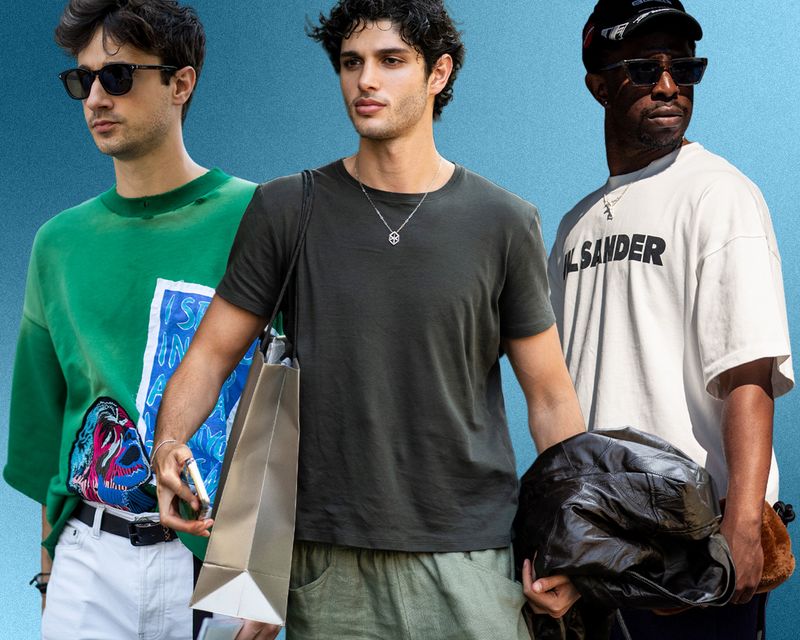THE JOURNAL

T-shirts first came into play in the late 1800s, when the US Navy began issuing white versions of them as standard undershirts. It’s down to F Scott Fitzgerald, who coined the term “T-shirt” in his 1920 debut novel This Side Of Paradise, that we now refer to the garment as such. It wasn’t before long, as with many military products – trench and peacoats, for instance – that the T-shirt made its way into the wardrobes of men not destined for the shores of enemy frontiers.
Marlon Brando turned the fortunes of the humble white tee after he wore one as Stanley Kowalski in 1951’s A Streetcar Named Desire. His Hollywood counterpart James Dean accelerated the garment’s rise in popularity when he wore one in 1955’s Rebel Without A Cause.
Today, white T-shirts – and every other version of tee – have moved on from just being in the wardrobes of very famous actors with attitude and instead are worn by anyone anywhere. In the 1980s, John F Kennedy Jr, when not in a suit, rocked T-shirts that hugged his athletic upper body, while Jeremy Allen White caused sales of white T-shirts to skyrocket in 2022 (and every summer since) when he sported one as The Bear’s Carmy. Austin Butler, Idris Elba and Callum Turner have cemented them as part of their own downtime wardrobes.
“To forgo T-shirts is to skimp on the most versatile item that a man can wear”
In short, to be without a T-shirt in your wardrobe is to essentially be incomplete. It’s the bread and butter of a proper capsule collection. To forgo T-shirts is to skimp on a very essential menswear item: the most versatile of all products that a man can wear. It’s the easiest garment to throw on when you don’t want to button up an Oxford. And a T-shirt can be paired with just about anything, be it shorts, chinos or smarter, wide-legged slacks. It’s the humble main character of any wardrobe and it has an unrivalled power. A year-round saviour, a T-shirt boasts style and practicality, with ease.
The easiest way to wear a T-shirt is, of course, on its own (plain is best), tucked into a pair of straight-leg jeans or pleated trousers. But a T-shirt has layering opportunities, too, which given the current climes, is probably how you’re thinking about styling one out. Wear yours beneath a linen shirt or paired with a canvas chore jacket and matching trousers like Jacob Elordi, or else with a blazer akin to how JFK Jnr would create a high-low aesthetic. Under a cotton crew-neck sweater, a sliver of tee offers its own styling edge, too.
“When buying a T-shirt, first think about its function, which will inform fit and style”
But your T-shirts needn’t always be plain. Striped, like those worn by Kurt Cobain and now mainstays in Mr P.’s collections, or raglan, are just as easy to wear. And we’re currently in a new era of slogan tees. Think Pedro Pascal repping the trans community at the London premiere of Thunderbolts* earlier this year. Meanwhile, Paul Mescal has been sporting graphic band tees endorsing the likes of Guns N’ Roses and The Clash. Japanese brand KAPITAL does its own graphic tees that riff on the band merch of the 1980s. More marks for band tees if they’re slightly cropped, too.
When buying a T-shirt, first think about its function, which will inform fit and style. Are you looking for a tee that will work well under your officewear? Well, we’d advise keeping the fit traditional with a tight crew neck and a slimmer shape, while the colour should be kept neutral, like white, grey or black. After a T-shirt that will add some pizzazz to your outfit? Stripes do that, without working too hard or making you look like you’re trying too hard. After a grocery store run fit that’ll have you looking like Mescal? An oversized band tee, a louche bomber jacket and a pair of shorts are a good way to go.
And when it comes to a T-shirt’s insurance policy – meaning you don’t need to rebuy one every six months – it’s wise to think about material before purchasing. One hundred per cent cotton tees are best, as not only will they retain their shape after washing, but they’re also breathable meaning less likelihood of nasty sweat stains. For printed styles, always wash inside out (unless they’re dry-clean only) and avoid fabric softeners that can degrade the print. Treat your tees well and they’ll repay you by becoming the sartorial backbone of your wardrobe.